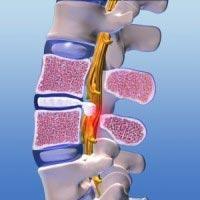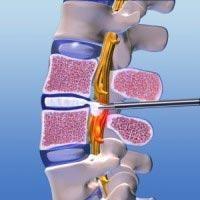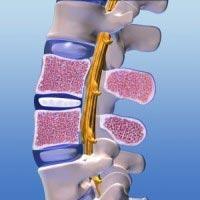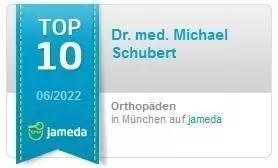Quick overview :
Intervertebral disc surgery - minimal - invasive = gentle - safe *
(endoscopically on the lumbar spine)
The most gentle disc surgery in the world!
If severe pain and neurological symptoms cannot be controlled with conservative measures, surgical treatment is necessary. The aim of endoscopic disc surgery is to remove the threatening disc tissue and thus relieve the pinched nerve spatially or completely expose it again.
We operate on a herniated disc endoscopically! With over 10,000 endoscopic disc operations, Dr. Schubert is the leading and most experienced spine surgeon in the world, both nationally and internationally. (see also news )
 The procedure does not require a large incision or a wide opening of the spinal canal and is therefore a gentle alternative to "open" surgery: Since there is no major tissue destruction, the risk of the dreaded scarring is very low. In addition, the intervention with that of Dr. Schubert further developed and modified TESSYS® and/or maxmore® method now apex (advanced percutaneous endoscopic access method) by ceptovation® much less stressful; the healing process or convalescence is also significantly shorter.
The procedure does not require a large incision or a wide opening of the spinal canal and is therefore a gentle alternative to "open" surgery: Since there is no major tissue destruction, the risk of the dreaded scarring is very low. In addition, the intervention with that of Dr. Schubert further developed and modified TESSYS® and/or maxmore® method now apex (advanced percutaneous endoscopic access method) by ceptovation® much less stressful; the healing process or convalescence is also significantly shorter.
Do you have any complaints?
Then use our online questionnaire - professional initial assessment in 48 hours
Endoscopic disc surgery
Minimally - invasive = gentle - safe *
Thanks to endoscopic disc surgery that is gentle on bone and tissue, we have a procedure at our disposal that allows us to repair a herniated disc in an even safer and more patient-friendly manner.
The most important difference compared to the conventional endoscopic procedure: The access to the site of the pain is not, as is usually the case, dorsal ("rear" access), but from the side, via the nerve exit hole (foramen). In this way, the nerve structures in the spinal canal are completely bypassed - and injuries, adhesions and other complications can be avoided. The ligaments between the vertebrae that stabilize the spine, the ligamentum flavum, also remain intact.
Because the lateral access allows for an approach that is both tissue-friendly and painless, general anesthesia is no longer necessary.
General anesthesia is a contraindication for most endoscopic disc operations! ... and has nothing to do with the experience of the operator!
How is endoscopic disc surgery treated?
Under local anesthesia, an optical endoscope equipped with various miniature working channels is gently advanced percutaneously to the herniated disc. The intervertebral disc tissue that has come out is now removed under visual control.
Protruding remnants are shrunk with a special laser. In certain cases, the core of the intervertebral disc is reduced with the help of a special enzyme in order to relieve the outer fibrous ring for subsequent healing. In order to support the revitalization of the intervertebral disc, the calcified cover plate of the adjacent vertebral bodies is freshened up using fine instruments, which improves blood circulation in the intervertebral disc and allows a firm, stable protective fiber ring to form. The endoscopic disc surgery takes about 30 to 45 minutes.
The animation video shows the course of an endoscopic disc operation
In total, the endoscopic intervertebral disc surgery takes about 30 to 45 minutes. The entry point is closed sterile with a small plaster.
The patient then comes to the recovery room for around 2 hours to be monitored. In patients who are in good general health, this procedure can also be performed on an outpatient basis.
A medical check-up takes place one day after the disc operation and then again three months later.
Endoscopic disc surgery is not the same as endoscopic disc surgery
 In most other endoscopic disc surgery methods, the "transforaminal approach" (lateral nerve exit hole) is also used, but the primary target is the disc space itself. Now, a loss of volume (vacuum) is caused by the removal of healthy disc material. This is intended to pull back the tissue that has protruded into the spinal canal and is pressing on the nerves. In some cases this works. Procedures with a similar philosophy are, for example, laser shrinkage, chemonucleolysis, alcohol gel injections or the suction method of healthy intervertebral disc material. The prospect of success, in addition to the risks of unnaturally rapid wear and tear of the intervertebral disc space and thus favored instability, is to be assessed as rather low.
In most other endoscopic disc surgery methods, the "transforaminal approach" (lateral nerve exit hole) is also used, but the primary target is the disc space itself. Now, a loss of volume (vacuum) is caused by the removal of healthy disc material. This is intended to pull back the tissue that has protruded into the spinal canal and is pressing on the nerves. In some cases this works. Procedures with a similar philosophy are, for example, laser shrinkage, chemonucleolysis, alcohol gel injections or the suction method of healthy intervertebral disc material. The prospect of success, in addition to the risks of unnaturally rapid wear and tear of the intervertebral disc space and thus favored instability, is to be assessed as rather low.
At the APEX SPINE Center by Dr. Schubert, the aim is to safely remove the herniated disc pressing on the nerves in the spinal canal, regardless of location and size, under endoscopic vision. The natural state of the intervertebral disc, as well as the mobility and stability of the movement segment, is thus fully preserved.
In other cases, the intervention is performed via the risky dorsal approach ("posterior" approach). The nerve-protecting spinal ligament - the ligamentum flavum - is always sacrificed and the nerves have to be pulled to the side, combined with a high risk of injury in order to reach the herniated disc. In this case, the operation can only be performed under general anesthesia, otherwise the pain would be unbearable for the patient.
What follow-up treatment is required after endoscopic disc surgery?
A medical check-up takes place on the day after the endoscopic disk operation. In addition, a physiotherapist discusses the rehabilitation program that is individually tailored to the patient. In the first two weeks after the procedure, you will wear a specially adapted plastic corset that relieves your back and allows you to resume your usual activities soon. It is recommended that you follow a postoperative treatment plan that is individually tailored to you, under the supervision of a physiotherapist, about a week after the disc surgery. After about 6 weeks you should start with muscle-strengthening exercises for the torso and back muscles. At the same time, a return to the usual physical activities (fitness and sport) is possible again.
You can also read detailed information on the post-operative treatment of an intervertebral disc in our “Postoperative Program” instructions for download.
 When can you play sports again after endoscopic disc surgery?
When can you play sports again after endoscopic disc surgery?
You should be able to swim or cycle regularly again about three weeks after the procedure. You can resume your usual athletic training about six weeks after the procedure.
When will you be able to work again after endoscopic disc surgery?
After one to two weeks, you can resume office work and light physical work. You should avoid heavy physical activity for the first six weeks and then slowly increase it.
What is the success rate after endoscopic disc surgery?
The success rate is largely dependent on the experience of the surgeon. In the international literature, success rates of around 80 - 90 percent are given.
In our own studies, we were able to achieve a success rate of 95% after endoscopic disc surgery! See also research results.
At a glance!
| The most important facts and data are summarized and compared for you at a glance | ||
|---|---|---|
| Conventional open disc surgery | Endoscopic disc surgery | |
| anesthesia | The patient is under general anesthesia. Risk of surgical damage to the central nerve. |
The operation is performed under local anesthesia. General anesthesia, as it is often advertised, is a contraindication! The patient is continuously monitored and put into a kind of twilight sleep. Nerve damage is therefore practically impossible. |
| storage | The patient lies prone and the back is opened centrally with a 4-8 cm incision | The patient lies on his side. The endoscopic access is carried out through an approx. 7 mm long lateral skin incision |
| risk |
|
|
| Pains | The level of pain after the operation tends to be very high. | There is little or no pain after the operation |
| After the procedure | As a rule, it is not possible to bear any weight on the back for up to 6 weeks after the operation. | You can leave the recovery room on your own two hours after the operation. |
| hospital stay | A stay in the clinic of 1-3 weeks may be required before the procedure | 1-2 days |
| surgery | The back muscles are separated from the bones in the affected segment, parts of the bones and ligaments are removed or severed - loss of stability and severe traumatization and the resulting pain are the result. | The surgeon only removes the offending disc tissue without damaging or removing surrounding structures such as bones, ligaments or muscles. This avoids instability or the dreaded scar tissue around the nerve. |
| Sports | Sport is only possible after approx. 4 - 6 weeks | Sport is already possible again after 2 weeks |
| meeting | Long waiting times are not uncommon | In acute cases, you can be operated on within 48 hours |
!!! The mobility and functionality of the spine is fully preserved after an endoscopic disc operation !!!
The advantages of endoscopic disc surgery at a glance:
- very high success rate> 95%
- very low infection rate <0.01%
- The operation is performed under local anesthesia ; no general anesthetic is necessary! On the contrary, general anesthesia is a contraindication for most endoscopic disc operations.
- In most cases there is immediate freedom from pain after the operation!
- Because hardly any tissue is destroyed, the procedure is less stressful and the risk of complications is low.
- No instability because the spine has stabilizing structures (vertebral ligaments, vertebral joints)
be left perfectly intact; in contrast to the microscopic technique - Reduced wound healing pain and increased stability because the back muscles do not have to be severed.
- Lower risk of infection as access is through a small skin incision (5mm).
- Reduced scarring in the nerve root area!
- You can walk pain-free just two hours after the operation.
- No longer hospital stay is necessary: you can go home one day after the operation.
- You can go back to your usual activities just a few days after the operation.
- A short convalescence: After one to two weeks you are able to work again,
after about six weeks you can go back to your usual sports. - The operation hardly leaves any scars.
* Every operation carries risks. No operation is 100 percent safe.



